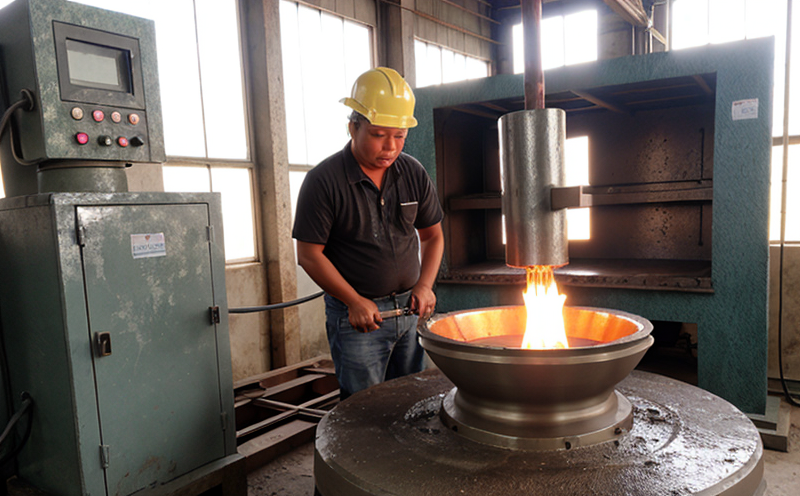ASTM A609 Ultrasonic Testing of Steel Castings
The ASTM A609 standard provides a comprehensive framework for ultrasonic testing (UT) of steel castings. This method is particularly useful in industrial manufacturing and processing sectors, where the integrity of large metal components plays a critical role. The primary objective of this test is to detect and characterize flaws within the casting that may compromise its structural integrity or performance.
The process involves directing high-frequency sound waves into the casting using an ultrasonic probe. These waves propagate through the material; any irregularities cause reflections, which are then captured by a transducer and translated into electrical signals for analysis. Flaws such as porosity, shrinkage cavities, cracks, and inclusions can be identified based on these signals.
ASTM A609 specifies the types of probes to use, the frequency range, and the operating conditions that ensure accurate testing. It also provides guidelines for specimen preparation, including cleaning, drying, and positioning the casting relative to the probe. The standard outlines acceptance criteria, which define the permissible levels of defects based on the casting's intended application.
In industrial manufacturing, especially in sectors like automotive, aerospace, and defense, where safety and reliability are paramount, ASTM A609 UT is a critical quality control measure. It helps manufacturers ensure that components meet the stringent requirements set by international standards such as ISO 17645:2003.
The ultrasonic testing process is non-destructive, meaning it does not alter or damage the casting during inspection. This makes it an ideal choice for quality assurance and compliance with regulatory requirements. It also allows for repeated inspections without compromising the integrity of the component, making it a cost-effective solution in the long run.
Real-world applications of ASTM A609 UT include the production of large castings such as engine blocks, transmission cases, and structural components used in heavy machinery. The testing ensures that these parts are free from defects that could lead to failures during operation, thereby enhancing safety and reliability.
- Economic benefits: Reduced waste due to rework or scrapping of defective components
- Operational efficiency: Faster identification and rectification of flaws
- Safety enhancement: Prevention of accidents caused by structural failures in critical components
- Regulatory compliance: Meeting the stringent requirements set by international standards like ASTM A609 and ISO 17645
The use of ultrasonic testing not only enhances product quality but also contributes to sustainable manufacturing practices. By identifying defects early in the production process, manufacturers can minimize environmental impact through reduced material usage and energy consumption.
Benefits
Implementing ASTM A609 Ultrasonic Testing offers numerous benefits for industrial manufacturers:
- Enhanced Quality Control: Ensures that all steel castings meet the highest quality standards, reducing the risk of defects.
- Precision and Reliability: Provides accurate detection of internal flaws using advanced ultrasonic technology.
- Non-Destructive Inspection: Allows for repeated inspections without compromising the integrity of the casting.
- Cost-Effective: Minimizes waste through early defect identification, leading to reduced material costs and scrap rates.
- Compliance with International Standards: Ensures that all testing adheres to ASTM A609 and other relevant international standards.
The non-destructive nature of ultrasonic testing also allows for real-time monitoring during the manufacturing process, providing immediate feedback on quality. This capability is particularly valuable in high-volume production environments where maintaining consistent product quality is crucial.
In addition to these tangible benefits, ASTM A609 UT enhances the reputation of manufacturers by demonstrating a commitment to excellence and regulatory compliance. This can lead to increased customer trust and loyalty, as well as improved market positioning.
International Acceptance and Recognition
The ASTM A609 standard is widely recognized and accepted across various industries worldwide. It has been adopted by many international organizations, including the International Organization for Standardization (ISO) and the European Committee for Standardization (CEN). The standard's global acceptance ensures that manufacturers can confidently export their products to markets that have stringent quality requirements.
ASTM A609 UT is particularly valued in sectors where safety and reliability are critical, such as aerospace, automotive, and defense. These industries rely on the consistent quality of steel castings produced by manufacturers who adhere to this standard. The widespread adoption of ASTM A609 ensures that all parties involved can trust the integrity of the testing process.
The international recognition of ASTM A609 UT is further enhanced by its alignment with other relevant standards such as ISO 17645:2003 and EN 1088-1. These standards provide additional context and support for the ultrasonic testing process, ensuring that it meets the highest international quality benchmarks.
By adhering to ASTM A609, manufacturers demonstrate their commitment to excellence and regulatory compliance. This not only enhances their reputation but also opens up new market opportunities in regions with stringent quality standards. The global acceptance of this standard ensures that all parties involved can trust the integrity of the testing process, fostering a culture of reliability and safety across the industry.





